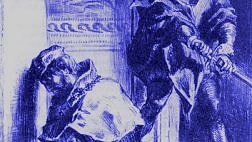 CHECK OUT YOUR FREE
CHECK OUT YOUR FREE
SAMPLE ESSAY BELOW

Check out your free
sample essay below

Essay introduction /
Thesis statement
“An act hath three branches”
Play-acting did not begin at Elsinore with the arrival of a troupe of fictional actors, played by real actors. The Players come to a castle where two theatrical performances are already in progress.
One is a charade of legitimate kingship, directed by and starring the usurping Claudius. The second work of theater is a one-man show of madness, written and performed by his nephew, Prince Hamlet.
Echoing the grave-digger’s comment that “an act hath three branches” (5.1), Hamlet the play can be regarded as an extended triple pun on the verb ‘to act.’ At Elsinore, the play’s characters variously take action, play false roles and perform in theater.
SHARE THE SHAKESPEARE
#Hamlet - A play-long pun on the verb 'to act': to do and to play a false role.
1
Claudius: the false monarch
“He that plays the king”
The playwright of providence cast Claudius as a secondary character in the shadow his brother, Old King Hamlet. But Claudius rewrites the script so that he now shares the throne and bed of Queen Gertrude.
Attempting to see behind the mask of Hamlet’s madness, Claudius directs or colludes in three ‘plays-within-a-play.’ But neither the false show of concern by Rosencrantz and Guildenstern nor the staged encounter with Ophelia “hold a mirror up to nature” (3.2). The third ploy, arranged with Polonius as the secret audience, marks the turning point after which events spiral out of Claudius’ control and his “sorrows come … not single spies, but in battalions” (4.5).
SHARE THE SHAKESPEARE
#Hamlet: Where appearance and reality are maddeningly and tragically far apart.
2
Polonius: political and family spymaster
“Seeing, unseen”
Not even his own son and daughter are safe from the duplicitous ploys of the king’s advisor, Polonius. He sends a spy Reynaldo to Paris to spread malicious lies about Laertes—“Your bait of falsehood takes this carp of truth” (2.1). He then exploits Ophelia’s relationship with Hamlet, directing her to stumble across the prince “as ’twere by accident” (3.1), while he and the king listen nearby, “seeing, unseen.”
Appropriately, Polonius dies as he lived, eavesdropping behind a curtain. “(F)arewell. I took thee for thy better,” says Hamlet (3.4). With deadly irony, the man, who in life so enjoyed acting as someone he was not, met his death because he was mistaken for someone else.
SHARE THE SHAKESPEARE
Polonius in #Hamlet - "If circumstances lead me, I will find / Where truth is hid."
3
Hamlet: the player prince
“I know not seems”
Like his creator, Prince Hamlet is an actor (“I perchance hereafter shall… To put an antic disposition on”, 1.5) and playwright (“The play’s the thing / Wherein I’ll catch the conscience of the king”, 2.2). For the first half of the play he is also a harsh theater critic of the other characters’ insincere performances. But his words and theatrics are not enough to unseat Claudius.
On his return to Elsinore, a changed Hamlet has decided he will no longer “like a whore, unpack my heart with words” (2.2). The prince has accepted the Everlasting as the playwright of his life and death: “There’s a special providence in the fall of a sparrow.” Whatever is destined to happen, will happen; “the readiness is all” (5.2).
SHARE THE SHAKESPEARE
Prince #Hamlet - "A knavish speech sleeps in a foolish ear."
4
Queen Gertrude
“Paint … an inch thick”
Claudius compares his masquerade of legitimate kingship with the make-up worn by a prostitute: “The harlot’s cheek, beautied with plastering art, / Is not more ugly to the thing that helps it / Than is my deed to my most painted word” (3.1). He continues the paint metaphor in 4.7: “Laertes, was your father dear to you? / Or are you like the painting of a sorrow, / A face without a heart?”
But, as Hamlet observes in the graveyard scene of 5.1, death will triumph over all painted makeup and disguises. Speaking to Yorick’s skull, he declares: “Now get you to my lady’s chamber, and tell her, let her paint an inch thick, to this favor she must come.”
SHARE THE SHAKESPEARE
Claudius fools everyone, except Prince #Hamlet. Gertrude fools only herself.
5
Essay conclusion / Summary
“Who’s there?”
“Who’s there?” asks the castle guard Barnardo as midnight approaches in the play’s very first line. His question expresses an underlying theme of the play: the difficulty of correctly identifying the true, authentic selves of others—and by extension, of distinguishing between appearance and reality, between what ‘seems’ and what ’is’.
Ironically, the watchful sentinel was looking in the wrong direction. The menace that doomed Denmark as an independent nation came from inside the walls of Elsinore itself. Denmark was not conquered by an external military campaign; it collapsed under a web of domestic deception.
SHARE THE SHAKESPEARE
#Hamlet - Barnardo and the castle guards were looking in the wrong direction.
6
The most helpful book ever for students and teachers of Shakespeare’s Hamlet.
42 x 1,500-word model essays

Chapter-by-chapter guide to Hamlet Model Essays
IN THIS BOOK ARE THREE 1,500-WORD SAMPLE ESSAYS ON EACH ONE OF THE FOLLOWING 14 CHARACTERS, RELATIONSHIPS, AND THEMES. THAT’S 42 SAMPLE ESSAYS IN TOTAL.

#1: The Character of Hamlet
Born a prince, parented by a jester, haunted by a ghost, destined to be killed for killing a king, and remembered as the title character of a play he did not want to be in. If at the cost of his life, Hamlet does in the end “win at the odds.”

#2: The Character of Claudius
His “ambition” for Denmark’s crown leads him to commit one murder only to find that he must plot a second to cover up the first. When this plan fails, his next scheme leads to the death of the woman he loves followed by his own.

#3: The Character of Gertrude
“Have you eyes?”, Prince Hamlet demands of his mother. Gertrude‘s “o’erhasty marriage” dooms her life and the lives of everyone around her when her wished-for, happy-ever-after fairytale ends in a bloodbath.

#4: The Character of Ophelia
As she struggles to respond to the self-serving purposes of others, Ophelia’s sanity collapses in Elsinore’s “unweeded garden” of falsity and betrayal. Her “self-slaughter” is her revenge for her silencing and humiliation.

#5: Relationship of Hamlet and the Ghost
Hamlet grants the Ghost the atonement his suffering soul needed more than the revenge he demanded: he surrenders Denmark to the son of the man murdered by his father on the day of the prince’s birth.

#6: Relationship of Hamlet and Claudius
Uncle and nephew are two men at war with each other—and themselves. Claudius is haunted by the murder he has committed (“O heavy burden!”); Hamlet by the one he hasn’t yet (“Am I a coward?”).

#7: Relationship of Hamlet and Gertrude
A haunted-by-the-past Hamlet seeks the truth about his father’s death (“Do you see nothing there?”). A live-in-the-present Gertrude seeks to protect her second husband and crown (“No, nothing but ourselves”).

#8: Relationship of Hamlet and Ophelia
Their relationship begins in uncertainty, descends into mutual deceit and rejection, and ends with their double surrender to death: Ophelia, to the water; Hamlet, to Claudius’ rigged fencing duel.

#9: Relationship of Hamlet and Horatio
“Those friends thou hast … Grapple them unto thy soul with hoops of steel.” Horatio is Hamlet’s trusted confidant in life and vows to remain the keeper of his memory after the prince’s death.

#10: Relationship of Claudius and Gertrude
A marriage of mutual self-interest: Claudius wanted to become king; Gertrude wanted to remain queen. In the end, both die by the same poison her second husband used to murder her first.

#11: Main Themes of Hamlet
A king murdered, an inheritance stolen, a family divided: Elsinore’s older generation destroys its younger when two brothers—one living, one undead—battle in a “cursed spite” over a crown and a queen.

#12: The Theme of Revenge
Hamlet and Laertes journey from revenge, through obsession and anger, to forgiveness. And the revenge sought by the Ghost on King Claudius becomes the revenge of Old King Fortinbras on Old King Hamlet.

#13: Deception and Appearance versus Reality
“Who’s there?” The characters struggle to distinguish between truth and falsehood in a play-long triple pun on the verb ‘to act’: to take action, to behave deceitfully, and to perform in theater.

#14: The Theme of Madness
“Your noble son is mad”, Polonius tells Denmark’s king and queen. But is Hamlet ever really insane? If not, why is he pretending to be? And is the prince’s “antic disposition” the cause of Ophelia’s traumatic breakdown?
















